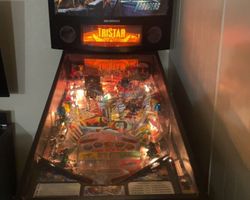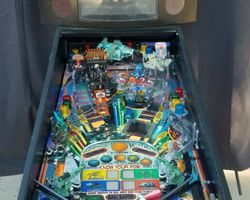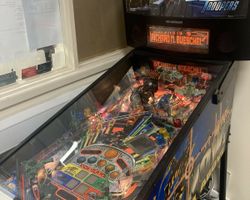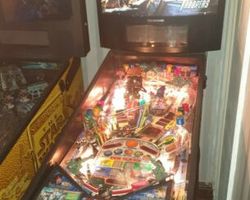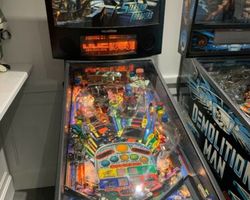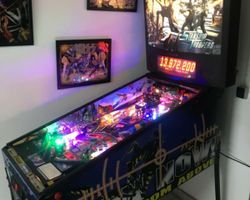Starship Troopers
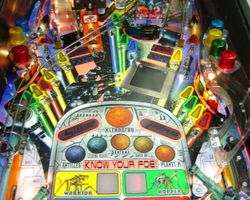
Average Prices: USD $800 to $2,200
Produced: December, 1997
Machine Type: Solid State Electronic
MPU: Sega/Stern Whitestar
Players: 6
Design by: Joe Kaminkow, Joe Balcer
Art by: Morgan Weistling
Music by: Brian Schmidt
Sound by: Brian Schmidt
Software by: Neil Falconer, Orin Day
Starship Troopers, a pinball machine from Sega Pinball, Incorporated, burst onto the scene in December 1997, offering players a frantic battle against an alien menace. Directly inspired by the visually striking 1997 science fiction film of the same name, this machine plunged players into a galactic war against hordes of Arachnid bugs. Its release came during a period of transition within the pinball industry, with Sega Pinball operating on its Whitestar system, a platform that enabled a new generation of solid-state electronic machines.
The creative vision for Starship Troopers was shaped by a dedicated team. Joe Balcer and Joe Kaminkow collaborated on the game's design, crafting a play experience intended to capture the relentless action of the movie. Morgan Weistling’s artwork defined the machine's visual identity, particularly on the playfield, where his vibrant colors depicted the chaotic battlefield. The auditory landscape was developed by Brian Schmidt, who composed the music and sound effects, while Neil Falconer and Orin Day handled the software development, bringing the rules and game progression to life. Kurt Andersen was responsible for the animations displayed on the dot-matrix display, further immersing players in the cinematic theme. Fred Young contributed voice characterizations, adding to the machine’s thematic authenticity. With a production run of 1,500 units, the Starship Troopers pinball machine became a tangible piece of pinball history from the late 1990s.
Signature Features and Design
The Starship Troopers pinball machine is characterized by several distinctive elements that elevate its gameplay and visual appeal. Dominating the playfield are two interactive bug toys: the "Brain Bug" and the "Warrior Bug." The Brain Bug, a menacing creature, periodically pops up from the playfield, presenting a dynamic target that requires precise shots to hit and capture. Adjacent to this, the "Warrior Bug" is a moving target, simulating a live-fire battle. These animated toys serve as central objectives, enhancing the theme by bringing the Arachnid threat directly into the player's view.
Further interactive features include a unique magnet situated within an orbit path. When activated, this magnet seizes the ball and propels it around the orbit into a multiball lock, creating a dramatic and satisfying shot that directly contributes to the game's high-energy multiball sequences. The machine also incorporates two right-side flippers, in addition to the standard left flipper, providing a total of three flippers for advanced ball control and shot opportunities. Four 8-segment LED counters are strategically placed on the playfield, offering immediate visual feedback on game progress. A subtle design detail is the machine’s backbox, which features a convex front, distinguishing its profile. On the playfield, two "drop shuttles" are integrated into the ramps, adding another layer of visual storytelling to the gameplay.
Playfield and Mechanics
The playfield of Starship Troopers is a meticulously designed combat arena, laid out to facilitate fast-paced action and strategic bug annihilation. Major shots include the left and right loops, and two prominent ramps, dubbed "STARSHIP" (left) and "TROOPERS" (right), which are critical for advancing Recon Levels. A central feature is the moving Warrior Target, a primary objective for initiating one of the machine’s multiple multiball modes.
The lower playfield houses a three-bumper area, typical of many pinball machines, adding an element of unpredictability to ball movement. Throughout the playfield, numerous Bug standup targets represent various bug species, identifiable by their distinct colors. These targets are central to the primary objective of clearing planets. The "Arm Nukes" hole serves as a target for collecting extra balls and activating Planet Multiball. A sinkhole dedicated to the Orbit Multiball lock provides a direct path to another multiball experience. The Recon Award scoop, located in the upper playfield, is where players collect various in-game bonuses and power-ups.
A notable mechanical feature is the mini-flipper, positioned on the lower right side of the playfield. While some players find this third flipper a secondary element, its strategic utility involves precise shots on specific bug standups, with successful hits counting as two eliminations. The artwork, primarily executed by Morgan Weistling, renders the playfield in bright, colorful detail, depicting a vibrant, chaotic battleground that pulls players into the Starship Troopers universe. The layout encourages a dynamic, fluid game, with paths designed to lead players naturally from bug attacks to multiball frenzy.
Gameplay Dynamics
The core objective in Starship Troopers is to annihilate all bugs across six distinct planets, presented in a fixed progression: Antilles, Zegema Beach, Dantana, Tango Urilla, Planet P, and finally, Klendathu. Each planet requires players to eliminate a specific number and type of bugs—Warriors, Hoppers, Plasma Bugs, and Tankers—by hitting the corresponding flashing Bug standup targets. Once a planet is cleared, the Brain Bug emerges, requiring multiple hits to capture for bonus points. Following the Brain Bug's capture, players face a tactical decision: advance to the next planet or initiate a Planet Multiball. Klendathu, the ultimate planet, demands the elimination of nine bugs of each type and completion of all Nuke shots, culminating in a significant 50 million point bonus upon completion.
The machine features multiple multiball modes, each with its own activation criteria and scoring opportunities. Planet Multiball is initiated by "nuking" one or more planets, requiring players to hit lit shots such as the Left loop, Left ramp, Recon scoop, Right ramp, Right loop, and the Arm Nukes hole to score jackpots and a Super Nuke. The number of balls and the value of jackpots scale with the number of planets nuked simultaneously. The Regular Multiball, also known as "Live Fire Assault Range Multiball," begins after hitting the Warrior target a specific number of times, increasing with each subsequent activation. This 4-ball multiball lights the ramps for jackpots, and clearing all Bug standups during this mode awards an Extra Ball. Orbit Multiball, a 2-ball mode, is activated by making two Orbit locks, each requiring three loop shots. Lit loops become jackpot targets, and this mode can escalate to a 4-ball frenzy.
Starship Troopers also includes various skill shots at the game's start, offering bonuses like a bonus multiplier, a ramp shot bonus, or an Orbit Multiball letter. The Recon Awards, collected via the Recon scoop, are crucial for progression and power-ups. Players advance Recon Levels by consistently shooting the STARSHIP and TROOPERS ramps. These awards encompass a wide range of benefits, from Ground Attack and Psychic Test modes to spotting bug species, holding bonus multipliers, lighting orbits, activating Super Pops, enabling Double Scoring, spotting planets, readying multiball, initiating Ramp Hurry-ups, Air Attack, and Nuke Chase, as well as awarding Extra Balls and substantial point bonuses. The "Are you Psychic?" video mode, displayed on the backbox, presents a card-matching game, adding an element of chance and diversion. Strategically, players often prioritize initiating the Regular and Orbit Multiballs early, while carefully considering when to trigger Planet Multiball for maximum impact by nuking multiple planets at once.
Reception and Legacy
The Starship Troopers pinball machine has garnered a largely positive reception within the pinball community, frequently cited as an underappreciated machine from the Sega Whitestar era. Its strengths are often highlighted by its fast-paced, smooth, and engaging gameplay. Many players describe it as challenging and addictive, emphasizing its capacity to provide continuous fun. The machine excels in its theme integration, leveraging the Starship Troopers film with thematic artwork, accurate callouts, and sound effects that immerse the player in the intergalactic conflict.
The inclusion of interactive toys, such as the unique moving Warrior Bug and the pop-up Brain Bug, is consistently praised for enhancing the play experience. The playfield artwork, created by Morgan Weistling, receives commendation for its bright and colorful design. Furthermore, the game’s accessible rules make it approachable for new players, while still offering sufficient challenge to keep experienced enthusiasts engaged. Its general market value also contributes to its positive standing, often considered a machine that delivers significant enjoyment for its price point.
However, the machine does face criticism in certain areas. The sound quality is sometimes described as basic, with repetitive music and recurring bug screams that some players find grating. While the playfield artwork is often lauded, the cabinet artwork is occasionally perceived as simplistic. Some players also note that the rule set, while accessible, lacks the deep complexity that might sustain long-term engagement for every player, potentially leading to repetition over extended play sessions. The third flipper, while offering unique shot opportunities, is occasionally dismissed by some as a superficial addition. Build quality, a frequent point of discussion for Sega machines of this era, receives mixed feedback; some consider it robust for a Sega title, while others suggest improvements could have been made. Despite these points of critique, Starship Troopers retains a respected position among Sega Pinball machines. Its focus on kinetic action, engaging interactive toys, and multiple multiball modes set a precedent for licensed sci-fi themes of its time, securing its place as an enjoyable and enduring title in pinball history.
Sponsored Links
 Ebay Listings
Ebay Listings
 Auction Results
Auction Results
| Cost | Location | Date |
|---|---|---|
| USD $3,500 |  Florida, United States Florida, United States |
04 October, 2025 |
| USD $5,000 |  Wyoming, United States Wyoming, United States |
16 February, 2024 |
| USD $3,400 |  Pennsylvania, United States Pennsylvania, United States |
24 May, 2022 |
| USD $3,500 |  North Carolina, United States North Carolina, United States |
29 April, 2022 |
| USD $6,750 |  California, United States California, United States |
01 February, 2022 |
| GBP £2,052 |  Plymouth, United Kingdom Plymouth, United Kingdom |
26 October, 2021 |
| GBP £2,549 |  Nuneaton, United Kingdom Nuneaton, United Kingdom |
07 September, 2021 |
| USD $3,700 |  Florida, United States Florida, United States |
27 June, 2021 |
| USD $5,479 |  Michigan, United States Michigan, United States |
25 April, 2021 |
| USD $5,999 |  California, United States California, United States |
03 April, 2021 |


Private Policy · Search Website · Contact Us
As an eBay Partner, we may earn a commission from qualifying purchases made through links on this site, at no additional cost to you.
All trademarks and copyrighted materials remain property of their respective owners. All other content copyright 2007 - 2025 Pinpedia.

